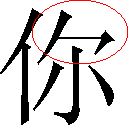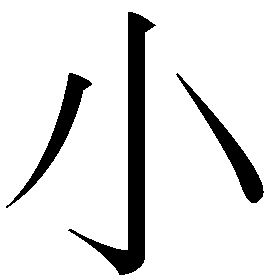| Learning to See Chinese Characters* -by David James Scott, Part 1 - Introduction Part 2 - The Chinese Dictionary Part 3 - Stroke Order and Radicals Part 4 - Yoda Speak and Good News Bad News This was originally titled "Learning to Read Chinese Characters", but I realized that I'm not going to try to teach you how to read Chinese. If you decide to embark on that course, the effort will take a few years. I've heard it described as "four years of drudgery", but I hesitate to call anything that I have this much fun with by that pejorative. Anyway, suggesting that you should learn to actually read Chinese characters is asking far too much of you, unless you are already well on your way with the language and have a burning desire to become fluent, in which case this could be a good introduction to concepts and principles you will need, and in which case you probably know everything I am going to tell you already. My intention here is simply to clear up some of the mystery about Chinese characters, and to give you an appreciation of this very different kind of writing. If I manage to inspired you to go further, and actually learn some Chinese, that would not be a bad thing. So when you read this, please don't make too much effort to remember the specifics of what I'm telling you. Just try to get the broad strokes, if you'll pardon the first pun. This is not HOW TO read Chinese characters, it's just ABOUT reading Chinese characters. When a westerner first looks at Chinese characters, they seem to be just a jumble of confusing lines with no rhyme or reason to them. The mind boggles. But as you start to see them, they quickly resolve into symbols that have meaning, not unlike letters in a word. Sometimes this doesn't help all that much, but keep in mind that Chinese children spend their first six years in school mostly doing nothing but learning Chinese characters. Don't expect to figure it all out by reading what I'm writing here. I'm going to try to explain them simply, as an introduction. Please understand that I don't speak much Chinese, or read many characters. This means that while I am not an expert in the background and history of Chinese characters, I can relate to where your head is at. So let me get you started, and you can take it from there....
Above are the first two characters I learned. Zhōng Guó, meaning "China". Once you know it, you can't miss it. It's everywhere in China, on banks and other buildings. I love this word.
And
Everybody thinks they are at the center of the action. The Romans called their part of the world "Mediterranean" - middle of the earth. At the same time, or maybe earlier, the Chinese started calling their part of the world "middle country" - the center of everywhere. Yet another proof that people are the same egocentric bunch no matter where they happen to stake out their home base. Once you can recognize zhōng guó, you might notice that the guó part is a box with something inside that looks like a capital I with one extra line and a little dash.
That's
Wáng,
As an aside, Wáng is now one of the most common Chinese names, familiar to everybody in the west to the point of being a cliché for a Chinese name, like our "Smith", or maybe "Scott". The reason this name is so common in China is that there was once an emperor named Wáng Quite a few people thought that they might get along better if they were one of his relatives. So many families started going by the name of Wáng. I don't think anybody was fooled, but it did set the tone for the whole country. Before I came to China, I thought that Chinese writing was basically pictures, and I more or less expected to be able to remember words once I knew what the picture was. Well, that may have been true in the ancient past. But not now. Not after thousands of years, many of which were spent trying to retain the elite status of the ruling class by keeping the peasants illiterate. Things got very confusing. For example, if I wanted to invent a pictogram for the word "face", I would probably come up with something resembling a happy face. Something like this
maybe:
Or if I wanted to stick
to simple straight lines, maybe something like this
And if this is too complex,
maybe we could simplify it:
Or maybe like this:
thinking about it and refinement,
something like this:
The point is, if you wanted to you could come up with a picture for "face" that anybody, even a person who didn't understand your language, would recognize and remember, even if it took a bit of help to get the exact meaning. This would work for a complete illiterate from anywhere in the world, and this should be the advantage, the only advantage, that a pictogram writing system has over a phonetic system. With a phonetic system, with the symbols/letters representing (approximating) sounds, you can sound out and guess at an unfamiliar word. But with a pictogram system, if you can't recognize the picture you have met what the Chinese call "a tiger in the path" and are completely lost. So the words in a pictogram system should be, one would think, memorable and easy to recognize. But that's not quite what
the Chinese have. Here's the Chinese word for "face",
Now maybe you are thinking that you see a Chinese hat there,
and maybe a nose and cheeks underneath it with something like a
ladder on one side. That's not what's happening. The
ladder is actually one of the most common Chinese "radicals"
(characters which form part of other characters and a major key to
reading Chinese). That ladder is
Now if I was going to draw something that would be the word for
moon, I could come up with something a lot more intuitive than
a ladder. Maybe something like this:
But now I find that I have already mislead you.
Those two lines beside the
You can sort of see that, right. It's like somebody viewed from the side with their arms tight to their body taking a big step. Two legs, and let's not bother with a head or shoulders or arms. Two legs is good enough. Except....... There I go again. This isn't rén at all. It only looks like rén. It's actually part of qiǎn, which means "together" but now is mostly used as a phonetic element to give some clue as to the pronunciation of the word. So it's included in liǎn, face, because qiān sounds like liǎn, uh.... almost. Okay, it rhymes with liǎn and that's close enough for a Chinese pronunciation guide. We might think they could do better, but it's not our system. (To be fair, the top part of qiǎn actually IS rén. Originally it was two rén, two people, and it meant "gather together".)
Anyway, if you can remember that
Let's get back to ren. "Person". Rén is really easy to remember and as a radical it forms part of a huge number of Chinese characters. Here it is again:
Just remember two legs and you've got it. Now, imagine a fisherman coming home and he's telling us about the fish that got away. So he holds his hands out like this....
You can see this, right? Well, this is dà, meaning big. Now, if you just add a little stroke to dà, a line which I remember by a certain vulgarism I'm not going to share with you, you have this character: And this is
And so it goes. Each Chinese character has something about it which makes it memorable, once you break it down into it's components, which people who talk about this kind of thing call "radicals". And then for some of the characters, maybe most of them, you just have to bite the bullet and outright memorize. We can go one step further with our
big fisherman,
Remember this, because I'm coming back to it soon. And while we are on the subject of heaven, here's a character that looks really similar to heaven, but you'll notice that the center line goes above the top line.
Now let's take look at the word
Nĭ , meaning "you", looks like this:
Now
hopefully you remember
Believe it
or not, rén
At the top on the right hand side of nĭ is something which, to me, looks a bit like a knee.
So this is how I remember the character and how it is pronounced. But what is that thing underneath the knee thingee you ask? Well,
do you remember dà,
Imagine if you took that fisherman guy named
This word is
So
I talked about
If you are saying hello to
more than one person, you add
If you look at that
What about
You'll see this sign a lot if you come to China. It's on the
door to most ladies washrooms, unless it's been replaced by
English. It looks far more complicated than it is, and
to write it actually only takes three strokes.
The second component or radical in
Let's take the radical idea one step further. There is another radical which means home or roof. It even looks a bit like a roof for a change.
On it's own it's called mián
You will find this character,
The first part of this,
Not that you are going to need
You will also find
As I mentioned earlier, there's a lot of sexism in the language of a culture,
particularly in the Chinese culture where for centuries women were
thought of as chattel, totally subservient to men. In
fact, according to Kongzi, known to the west as
Confucius, a woman during her life should observe the three
obediences: to her father when she is a child, to her
husband once married, and to her sons once she became a widow.
I'll probably be commenting on sexism in the characters and language
many times in this discussion. But first, here's the
character for man.
Once you start to see the radicals, you start to remember Chinese characters not by the individual lines but by the components. And then they get a lot easier to recognize. So here's the sign for the other washroom door, the one for "men". It's nán, and it looks like this:
If you've stuck with me this far, congratulations. We're almost through this first bit and you can go off and relax. So, Cousin Reta, when you come to China on your tour this May, you are almost sure to end up in Beijing, and if you get to Beijing you are almost sure to find yourself standing in front of the Forbidden City in one of the most famous squares in the world, Tiananmen Square. Believe it or not, you already know all the characters to read this name in Chinese. Here it is. See if you can figure it out:
That's it.
And that's enough to introduce you to Chinese characters. I hope you found this interesting, and enjoyed reading it. If so, please send an email to david@themaninchina.com with a few words of encouragement and I'll generate some more. It's a good way for me to learn characters, and a fun way to learn Chinese. Those of you who know the subject will know that I've only been talking about the modern, simplified characters used in Mainland China, not the unsimplified characters used in Taiwan or Vancouver. I've heard purists complain that the simplified characters have lost all the poetry and beautify of the originals, and are not nearly as interesting. I'm going to go with the majority on this one, and I'll look at the unsimplified characters once I have a bit of a grip on the ones most Chinese now use. For my Chinese students, and others who can actually read Chinese characters, if you found anything you consider a mistake, or anything that needs to be discussed, please also send me an email. david@themaninchina.com Thanks for reading. If you like your information animated with words and graphics, Ruth just found this great site to introduce Chinese characters and writing. It's well written, fast paced, and done by a guy who sounds very knowledgeable. Dikk Kelly has put together several great Power Point style presentations. Check them out. Learn To Read And Write Chinese Characters by Dikk Kelly This makes me feel like I've been reinventing the light bulb, and you're going to see some information that I've already covered, but repetition in different words is not a bad thing when you are trying to learn something. And what you get from me could be called "Learning Chinese with Attitude". In fact, that's what Ruth called it the other day. Okay, I'm ready for the next installment - Seeing Chinese Characters Part 2 The Man in China archive index
*I have several reference books from which I have learned what I know about reading Chinese characters. Anytime I am quoting one of them directly, I'll try to give credit where credit is due. The one I use most often is actually software installed on this computer. It's amazing, and allows me to have instant translations of English into Chinese with both the character and the pinyin pronunciation guide. In addition I can use it to look up characters I don't know by searching the radicals , find combinations of characters that form words (listed by most common), and get historical information about character origins and evolution. It's fabulous software folks, and if you can find it someplace it's worth whatever you pay for it.
Wenlin Software for
Learning Chinese version 3.0 Copyright [c] 1997 - 2002 the
Wenlin
Institute In addition I have a stack of books for learning Chinese: The one that I get much of my background information from is "A Key to Chinese Speech and Writing" by Joël Ballassen (University of Paris 7) with the Collaboration of Zhang Pengpeng (Beijing Language and Culture University) and Christian Artuso (Translator) published by Sinolingua, Beijing ISBN 7-80052-507-4 I'm also regularly dipping into "The New Age Concise Chinese - English Dictionary" published by The Commercial Press. Chief Editor, Pan Shaozhong ISBN 7 -100-03448-5/H-878
|
 zhōng
guó, "China"
zhōng
guó, "China" Zhōng
means "middle". It's easy to remember because it's just a square
with a line through the middle.
Zhōng
means "middle". It's easy to remember because it's just a square
with a line through the middle.  guó
means "country". So
guó
means "country". So
 yù
which means
"jade". Originally it was three beads on a string
and the little dash was added to distinguish it from wàng which
means "emperor" (a guy who had a lot of jade).
yù
which means
"jade". Originally it was three beads on a string
and the little dash was added to distinguish it from wàng which
means "emperor" (a guy who had a lot of jade).



 or this:
or this:
 , or even, after five thousand years of
, or even, after five thousand years of

 and this is more or less how it started out, apparently.
Something like this:
and this is more or less how it started out, apparently.
Something like this:
 Which
is at least a little representational and almost recognizable as a
moon. And then it just got more and more distorted and
stylized through the centuries. So
now this is what we've got.
Which
is at least a little representational and almost recognizable as a
moon. And then it just got more and more distorted and
stylized through the centuries. So
now this is what we've got. 





 tiān
tiān This is fū, which means "husband". His
head is above heaven. Get it? Not the first or the last
example of sexism in language I'm afraid.
This is fū, which means "husband". His
head is above heaven. Get it? Not the first or the last
example of sexism in language I'm afraid.
 which means "you
good", which means "hello". This is probably the most
commonly spoken word in China. It is pronounced like "knee
how", but with a falling and rising tone on both words.
That's what the little marks on top of the ĭ and the ǎ mean.
(I'll get into pronunciation some other time. For the moment I
want to concentrate on characters.)
which means "you
good", which means "hello". This is probably the most
commonly spoken word in China. It is pronounced like "knee
how", but with a falling and rising tone on both words.
That's what the little marks on top of the ĭ and the ǎ mean.
(I'll get into pronunciation some other time. For the moment I
want to concentrate on characters.)

 men to the nĭ to make it
plural.
men to the nĭ to make it
plural.
 n
n n
n mén, meaning "door" or "gate".
It's another one that is easy to remember. It looks like a
doorway or gate, which is a good thing too because this is the
second one I'm coming back to in a minute. So just
stick
mén, meaning "door" or "gate".
It's another one that is easy to remember. It looks like a
doorway or gate, which is a good thing too because this is the
second one I'm coming back to in a minute. So just
stick


 That's another thing about Chinese characters.
Once you understand the strokes and the stroke order, they get
a lot easier to see, read, remember, and
reproduce. Every character is made with specific sequences of
strokes that are never varied and have a certain logic to them.
Stroke order is something else we can get to later.
That's another thing about Chinese characters.
Once you understand the strokes and the stroke order, they get
a lot easier to see, read, remember, and
reproduce. Every character is made with specific sequences of
strokes that are never varied and have a certain logic to them.
Stroke order is something else we can get to later. 

 ,
gōng ān.
,
gōng ān.




